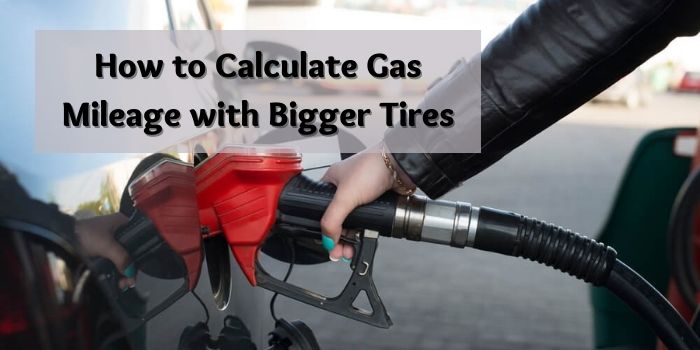Bigger tires can be a significant upgrade if you are looking for more off-road action with your vehicle. They will last long will provide better comfort than regular-sized tires.
While that is true, a drawback of using bigger tires is the decrease in gas mileage. But how much reduction do you face when you switch to bigger tires?
Well, you can easily find this out by doing some simple calculations. And in this article, we will explain how to calculate gas mileage with bigger tires in two different ways with step-by-step guides.
So, without further ado, let’s dive into the details!
General Steps for Calculating Gas Mileage for Bigger Tires

There are a few steps that you will need to follow before going with different methods for calculating the gas mileage of stretched tires. You can’t ignore these necessary steps if you want an accurate result. Here are the steps you will need to follow:
Step 1: Find Out the Capacity of the Vehicle’s Tank
You can find out your vehicle’s tank’s capacity by searching up the model on the internet. It is also included in the manual of the vehicle.
But to be sure, we suggest that you empty your vehicle’s tank and fill it up from the nearest gas station. From there, you can easily find out how many gallons can your vehicle’s tank take. This way, there will be no doubts regarding the tank capacity.
Step 2: Find Out the Tire’s Diameter
The tire’s diameter plays a significant role in calculating the gas mileage, especially if you are calculating it for big tires.
It is often found written on the tire’s body. You can also find it from your purchase papers or visit the manufacturer’s website.
Step 3: Choose Your Preferred Method
Once you are done with the previous two steps, you can choose a method of your choice and find out your vehicle’s gas mileage.
Odometer Reset Method
This is the most common and recommended way of calculating the gas mileage of vehicles. You will have to reset your vehicle’s odometer and do the necessary calculations in this scenario. Here is how you should proceed with the task:
- If you are using a digital odometer, simply pressing the reset button will do the trick. Otherwise, you will have to find the knob located in the instrument cluster. Press and hold the knob until the odometer resets.
- Now drive the car in the usual manner until you run out of gas.
- Return to the gas station and monitor how much gas it took for the tank to be completely depleted. This way, you will get the total travel distance and the total gas requirement.
- Now, divide the total miles traveled with the total gallons of gas required to fill the tank. The calculated result will be the gas mileage with your new tires.
Odometer Non-Reset Method
Odometer readings start to provide incorrect numbers if there is a drastic change in tire size. Now, if you don’t want to reset the odometer, then you will have to find the error percentage of your odometer is off and then calculate the gas mileage. Here is how you can do it:
- Start off by finding the odometer off/error percentage; make sure you have driven the car at full tank capacity and completely depleted the gas.
- Divide the old tire’s diameter with the new ones and subtract the result from 1.00
- Multiply the subtracted result with 100, and you will get the odometer error percentage.
- Next, multiply the error percentage by the distance you have traveled after installing the tires. You should count the distance from the odometer.
- Add the result with the traveled distance after installation, and you will get the total distance you have traveled with your tire.
- Divide the total travel distance with the total gas requirement, and the result is your new gas mileage.
This method can seem a bit more complicated than the previous one. But if you want to keep your odometer results or can’t reset the odometer, then going with this method is the best option.
Calculate Your Gas Mileage Now!
Gas mileage is a big concern for many when they transit from standard tires to bigger ones. But calculating them in different situations can bring out the pros and cons of having bigger tires.
Hopefully, after reading this, you now know how to calculate gas mileage with bigger tires! Utilize this knowledge and determine what type of impact bigger tires have on gas mileage!